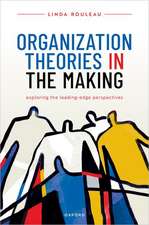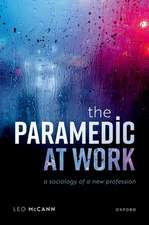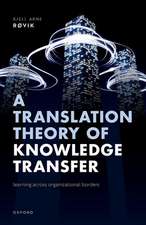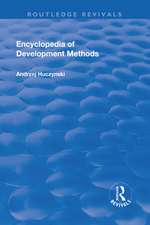Organizational Culture in Action: A Cultural Analysis Workbook
Autor Gerald W. Driskill, Angela Laird Brentonen Limba Engleză Paperback – 8 noi 2010
Based on more than 20 years of experience the authors help students apply cultural insights to fostering diversity, supporting organizational change, making leadership more dynamic, exploring the link between ethics and culture, and making organizations more effective overall.
Unique to Organizational Culture in Action are the various examples the authors have included, which are taken from their consulting experience with more than 150 organizations. An example analysis from a student has also been included to show novice researchers how they too can improve their organizational performance using this workbook.
Preț: 929.10 lei
Preț vechi: 1133.06 lei
-18% Nou
Puncte Express: 1394
Preț estimativ în valută:
177.78€ • 186.12$ • 147.10£
177.78€ • 186.12$ • 147.10£
Carte tipărită la comandă
Livrare economică 07-21 aprilie
Preluare comenzi: 021 569.72.76
Specificații
ISBN-13: 9781412981088
ISBN-10: 1412981085
Pagini: 256
Dimensiuni: 216 x 279 x 19 mm
Greutate: 0.6 kg
Ediția:Second Edition
Editura: SAGE Publications
Colecția Sage Publications, Inc
Locul publicării:Thousand Oaks, United States
ISBN-10: 1412981085
Pagini: 256
Dimensiuni: 216 x 279 x 19 mm
Greutate: 0.6 kg
Ediția:Second Edition
Editura: SAGE Publications
Colecția Sage Publications, Inc
Locul publicării:Thousand Oaks, United States
Recenzii
"This workbook does a tremendous job of making a lot of complex information easy to understand and apply to real situations."
"Excellent and most applicable for any organization going through restructuring."
"Excellent and most applicable for any organization going through restructuring."
Cuprins
Preface
Acknowledgments
Part I. CULTURAL ANALYSIS PLANNING
1. Introduction: Setting the Stage
Rehearsal 1.1 Applying the Drama Metaphor
Rehearsal 1.2 Determining Your Purposes for a Cultural Analysis
Rehearsal 1.3 Identifying an Organization
Rehearsal 1.4 Method Acting and Getting Real
2. The Significance of the Stage
Rehearsal 2.1 Creativity and Constraint
Rehearsal 2.2 The Value of a Cultural Analysis
Rehearsal 2.3 The Value of a Culture Analysis
Part II. CULTURAL ANALYSIS BASICS
3. Step One--Understanding the Concept of Culture: Constructing the Set
Rehearsal 3.1 How Do You Define Culture?
Rehearsal 3.2 Playing With Metaphors
Rehearsal 3.3 Writing a Cultural Analysis Proposal
4. Step Two--Identifying Cultural Elements: Understanding Roles
Rehearsal 4.1 Exploring Websites
Rehearsal 4.2 Getting More From Our Stories
Rehearsal 4.3 A Game of Metaphors
Part III. CULTURAL DATA COLLECTION AND INTERPRETATION
5. Method Acting: Textual Analysis
Rehearsal 5.1 Selecting Texts for Analysis
Rehearsal 5.2 Content Analysis
Rehearsal 5.3 Critical Linguistic Analysis
6. Method Acting: Observation
Rehearsal 6.2 A Potpourri of Things to Observe in Cultural Analysis
Rehearsal 6.3 Alien Culture Observation
Rehearsal 6.4 Note-Taking Guidelines
7. Method Acting: Interviews and Surveys
Rehearsal 7.1 Sample Interview Questions for “Reading” a Culture
Rehearsal 7.2 Alien Culture Interviews/Surveys
8. Step Four--Synthesizing and Interpreting Cultural Data: Getting Inside the Character
Rehearsal 8.1 Finding a Theme
Rehearsal 8.2 A Practice Stage
Rehearsal 8.3 Reliability/Validity Check
Rehearsal 8.4 Cultural Analysis Write-Up Guides
Part IV. CULTURAL ANALYSIS APPLICATION
9. Casting Against Type: Diversity
Rehearsal 9.2 Are You a Privileged Member of Your Organizational Culture?
Rehearsal 9.2 Diversity Survey
10. Improvisation: Managing Change
Rehearsal 10.1 Forces Driving Change
Rehearsal 10.2 Adapting Change Messages to the Culture
Rehearsal 10.3 A Change Plan
Rehearsal 10.4 A Change Case
11. An Honest Portrayal: Ethics
Rehearsal 11.1 Ethical Heroes
Rehearsal 11.2 Applying the Economizing Value Tension
Rehearsal 11.3 Applying the Power Distancing Value Tension
Rehearsal 11.4 Applying the Ecologizing Value Tension
Rehearsal 11.5 Other Value Tensions
Rehearsal 11.6 Ethics and Communication Leadership
7. Method Acting: Interviews and Surveys
Rehearsal 7.1 Sample Interview Questions for “Reading” a Culture
Rehearsal 7.2 Alien Culture Interviews/Surveys
8. Step Four: Synthesizing and Interpreting Cultural Data: Getting Inside the Character
Rehearsal 8.1 Finding a Theme
Rehearsal 8.2 A Practice Stage
Rehearsal 8.3 Reliability/Validity Check
Rehearsal 8.4 Cultural Analysis Write-Up Guides
Part IV. CULTURAL ANALYSIS APPLICATION
9. Casting Against Type: Diversity
Rehearsal 9.2 Are You a Privileged Member of Your Organizational Culture?
Rehearsal 9.3 Diversity Survey
10. Improvisation: Managing Change
Rehearsal 10.1 Forces Driving Change
Rehearsal 10.2 Adapting Change Messages to the Culture
Rehearsal 10.3 A Change Plan
Rehearsal 10.4 A Change Case
11. An Honest Portrayal: Ethics
Rehearsal 11.1 Ethical Heroes
Rehearsal 11.2 Applying the Economizing Value Tension
Rehearsal 11.3 Applying the Power Distancing Value Tension
Rehearsal 11.4 Applying the Ecologizing Value Tension
Rehearsal 11.5 Other Value Tensions
Rehearsal 11.6 Ethics and Communication Leadership
12. The Director’s Chair: Symbolic Leadership
Rehearsal 12.2 Assessing Yourself as a Leader
Rehearsal 12.3 Case Study of Cultural Leadership
13. Reading Reviews: Organizational Effectiveness
Rehearsal 13.1 How Do You Measure Effectiveness?
Rehearsal 13.2 Finding the Drawbacks of the Best Fit
Rehearsal 13.3 Gauging Effectiveness
14. Opening Night: Conclusion
Rehearsal 14.1 Action Plan for Professional Communication Development
Rehearsal 14.2 Organizational Development Action Plan
Appendix: Example Student Analysis
References
Index
About the Authors
Rehearsal 6.1 Identifying Six Types of Rites/Rituals
Rehearsal 9.1 Assess the Multiculturism of Your Organization
Rehearsal 12.1 Identifying Leader Reframing Practices
Acknowledgments
Part I. CULTURAL ANALYSIS PLANNING
1. Introduction: Setting the Stage
Rehearsal 1.1 Applying the Drama Metaphor
Rehearsal 1.2 Determining Your Purposes for a Cultural Analysis
Rehearsal 1.3 Identifying an Organization
Rehearsal 1.4 Method Acting and Getting Real
2. The Significance of the Stage
Rehearsal 2.1 Creativity and Constraint
Rehearsal 2.2 The Value of a Cultural Analysis
Rehearsal 2.3 The Value of a Culture Analysis
Part II. CULTURAL ANALYSIS BASICS
3. Step One--Understanding the Concept of Culture: Constructing the Set
Rehearsal 3.1 How Do You Define Culture?
Rehearsal 3.2 Playing With Metaphors
Rehearsal 3.3 Writing a Cultural Analysis Proposal
4. Step Two--Identifying Cultural Elements: Understanding Roles
Rehearsal 4.1 Exploring Websites
Rehearsal 4.2 Getting More From Our Stories
Rehearsal 4.3 A Game of Metaphors
Part III. CULTURAL DATA COLLECTION AND INTERPRETATION
5. Method Acting: Textual Analysis
Rehearsal 5.1 Selecting Texts for Analysis
Rehearsal 5.2 Content Analysis
Rehearsal 5.3 Critical Linguistic Analysis
6. Method Acting: Observation
Rehearsal 6.2 A Potpourri of Things to Observe in Cultural Analysis
Rehearsal 6.3 Alien Culture Observation
Rehearsal 6.4 Note-Taking Guidelines
7. Method Acting: Interviews and Surveys
Rehearsal 7.1 Sample Interview Questions for “Reading” a Culture
Rehearsal 7.2 Alien Culture Interviews/Surveys
8. Step Four--Synthesizing and Interpreting Cultural Data: Getting Inside the Character
Rehearsal 8.1 Finding a Theme
Rehearsal 8.2 A Practice Stage
Rehearsal 8.3 Reliability/Validity Check
Rehearsal 8.4 Cultural Analysis Write-Up Guides
Part IV. CULTURAL ANALYSIS APPLICATION
9. Casting Against Type: Diversity
Rehearsal 9.2 Are You a Privileged Member of Your Organizational Culture?
Rehearsal 9.2 Diversity Survey
10. Improvisation: Managing Change
Rehearsal 10.1 Forces Driving Change
Rehearsal 10.2 Adapting Change Messages to the Culture
Rehearsal 10.3 A Change Plan
Rehearsal 10.4 A Change Case
11. An Honest Portrayal: Ethics
Rehearsal 11.1 Ethical Heroes
Rehearsal 11.2 Applying the Economizing Value Tension
Rehearsal 11.3 Applying the Power Distancing Value Tension
Rehearsal 11.4 Applying the Ecologizing Value Tension
Rehearsal 11.5 Other Value Tensions
Rehearsal 11.6 Ethics and Communication Leadership
7. Method Acting: Interviews and Surveys
Rehearsal 7.1 Sample Interview Questions for “Reading” a Culture
Rehearsal 7.2 Alien Culture Interviews/Surveys
8. Step Four: Synthesizing and Interpreting Cultural Data: Getting Inside the Character
Rehearsal 8.1 Finding a Theme
Rehearsal 8.2 A Practice Stage
Rehearsal 8.3 Reliability/Validity Check
Rehearsal 8.4 Cultural Analysis Write-Up Guides
Part IV. CULTURAL ANALYSIS APPLICATION
9. Casting Against Type: Diversity
Rehearsal 9.2 Are You a Privileged Member of Your Organizational Culture?
Rehearsal 9.3 Diversity Survey
10. Improvisation: Managing Change
Rehearsal 10.1 Forces Driving Change
Rehearsal 10.2 Adapting Change Messages to the Culture
Rehearsal 10.3 A Change Plan
Rehearsal 10.4 A Change Case
11. An Honest Portrayal: Ethics
Rehearsal 11.1 Ethical Heroes
Rehearsal 11.2 Applying the Economizing Value Tension
Rehearsal 11.3 Applying the Power Distancing Value Tension
Rehearsal 11.4 Applying the Ecologizing Value Tension
Rehearsal 11.5 Other Value Tensions
Rehearsal 11.6 Ethics and Communication Leadership
12. The Director’s Chair: Symbolic Leadership
Rehearsal 12.2 Assessing Yourself as a Leader
Rehearsal 12.3 Case Study of Cultural Leadership
13. Reading Reviews: Organizational Effectiveness
Rehearsal 13.1 How Do You Measure Effectiveness?
Rehearsal 13.2 Finding the Drawbacks of the Best Fit
Rehearsal 13.3 Gauging Effectiveness
14. Opening Night: Conclusion
Rehearsal 14.1 Action Plan for Professional Communication Development
Rehearsal 14.2 Organizational Development Action Plan
Appendix: Example Student Analysis
References
Index
About the Authors
Rehearsal 6.1 Identifying Six Types of Rites/Rituals
Rehearsal 9.1 Assess the Multiculturism of Your Organization
Rehearsal 12.1 Identifying Leader Reframing Practices
Notă biografică
Dr. Gerald W. Driskill (Ph.D., University of Kansas; M.A., & B.A., Abilene Christian University)is an Associate Professor of Speech Communication at the University of Arkansas at Little Rock. He has taught graduate classes in Organizational Culture and Intercultural Communication since 1993 at UALR. He has taught Managerial Communication in Bangkok, Thailand and has also published a number of organizational communication articles from observation and interview transcript analysis in a multinational firm to analysis of communication patterns in day care cultures. He has served as a President of the local chapter of ASTD (American Society for Training and Development). The workbook grew from his collaboration with Dr. Brenton as he received positive feedback from mid-level managers and others in the ASTD network that used the course material in their own organizations.
Gerald continues to teach in the areas of organizational and intercultural communication. On campus he continues to take a lead role in internationalizing the curriculum. His current participant observer research focuses on communication and unity among religious, non-profit, and government organizations engaged in community building. This research provides a window into issues relevant to leaders creating a culture of community mindedness within their organizations.
Gerald continues to teach in the areas of organizational and intercultural communication. On campus he continues to take a lead role in internationalizing the curriculum. His current participant observer research focuses on communication and unity among religious, non-profit, and government organizations engaged in community building. This research provides a window into issues relevant to leaders creating a culture of community mindedness within their organizations.
Descriere
This stimulating workbook will guide students through data collection, analysis, interpretation and application of organizational culture data using a practical, five-step process.






















